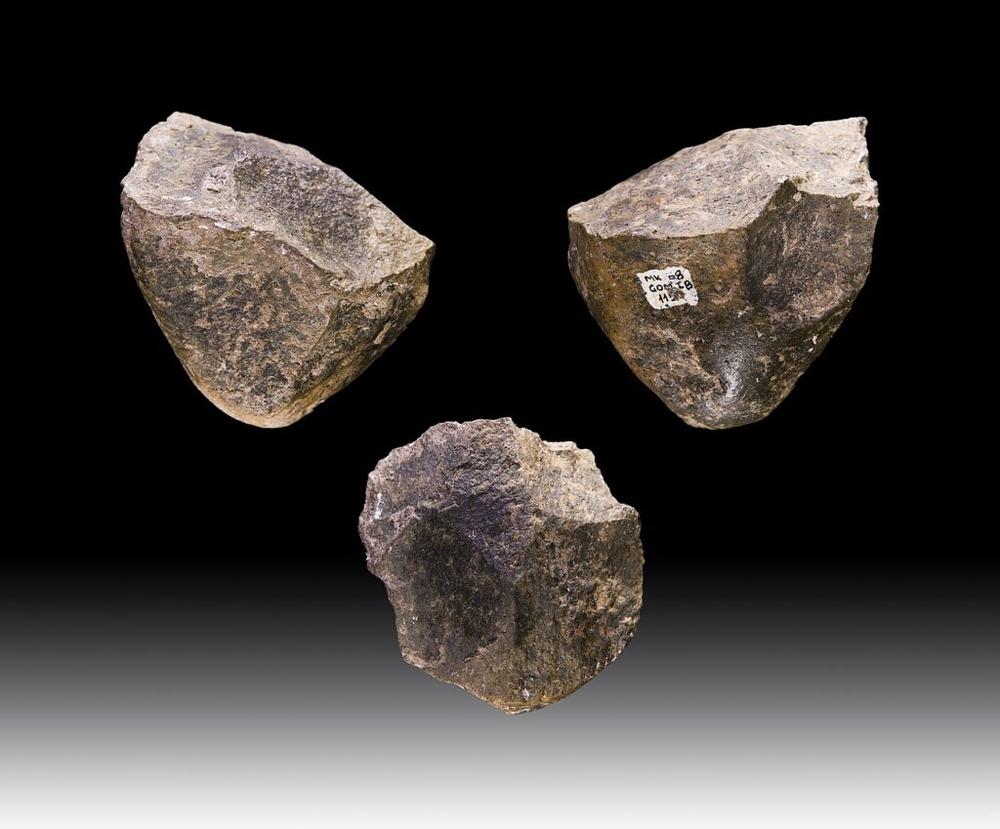At a site in Kenya, archaeologists recently unearthed layer upon layer of stone stools from deposits that span 300,000 years, and include a period of intense environmental upheaval. The oldest tools at the site date back to 2.75 million years ago. According to a recent study, the finds suggest that for hundreds of millennia, ancient hominins relied on the same stone tool technology as an anchor while the world changed around them.
“An extraordinary story of cultural continuity”
George Washington University archaeologist David Braun and his colleagues recently unearthed stone tools from a 2.75 million-year-old layer of Kenyan sediment at a site called Nomorotukunan. They’re classic examples of a type of tools archaeologists call Oldowan: the earliest types of sharp-edged stone tools made by hominins. The tools unearthed at Nomorotukunan are some of the oldest Olduwan tools ever found; only three other Oldowan sites in Africa date back any farther than 2.6 million years ago.
These hand-sized chunks of river rock, with flakes chipped off one or two sides to make sharp edges, were cutting-edge technology (not sorry) from 2.9 million years ago until about 1.7 million years ago. In technical terms, that’s what’s called a long flipping time, enough to span several hominin species and more than one genus. The last hominins to use Oldowan tools looked very different, and probably lived and behaved very differently, from the first; over this huge span of time, the stone tool technology itself changed less than the beings using it.
But archaeologists typically only see brief snippets of that massive longevity, from a generation or two of hominins at each site. The fact that Nomorotukunan has so many layers of sediment laden with artifacts, and that those layers span such a huge swath of time, is a rare gift from the usually fickle hands of taphonomic fate. Nomorotukunan’s palimpsest of river sediment, interspersed with volcanic tuff, records 300,000 years of hominins making the same types of tools with the same finely honed skills, before ending around 2.44 million years ago.
To put it in context: members of some ancient hominin species—maybe of more than one—passed the knowledge of these particular flint-knapping techniques down through about 10,000 generations (if you assume, for the sake of easy division, that a generation is about 30 years) at this one site.
“This site reveals an extraordinary story of cultural continuity,” said Braun in a recent press release.
When the going gets tough, the tough make tools
Nomorotukunan’s layers of stone tools span the transition from the Pliocene to the Pleistocene, during which Earth’s climate turned gradually cooler and drier after a 2 to 3 million-year warm spell. Pollen and other microscopic traces of plants in the sediment at Nomorotukunan tell the tale: the lakeshore marsh gradually dried up, giving way to arid grassland dotted with shrubs. On a shorter timescale, hominins at Nomorotukunan faced wildfires (based on microcharcoal in the sediments), droughts, and rivers drying up or changing course.
“As vegetation shifted, the toolmaking remained steady,” said National University of Kenya archaeologist Rahab N. Kinyanjui in a recent press release. “This is resilience.”
Making sharp stone tools may have helped generations of hominins survive their changing, drying world. In the warm, humid Pliocene, finding food would have been relatively easy, but as conditions got tougher, hominins probably had to scavenge or dig for their meals. At least one animal bone at Nomorotukunan bears cut marks where long-ago hominins carved up the carcass for meat—something our lineage isn’t really equipped to do with its bare hands and teeth. Tools also would have enabled early hominins to dig up and cut tubers or roots.
It’s fair to assume that sharpened wood sticks probably also played a role in that particular work, but wood doesn’t tend to last as long as stone in the archaeological record, so we can’t say for sure. What is certain are the stone tools and cut bones, which hint at what Utrecht University archaeologist Dan Rolier, a coauthor of the paper, calls “one of our oldest habits: using technology to steady ourselves against change.”
A tale as old as time
Nomorotukunan may hint that Oldowan technology is even older than the earliest tools archaeologists have unearthed so far. The oldest tools unearthed from the deepest layer at Nomorotukunan are the work of skilled flint-knappers who understood where to strike a stone, and at exactly which angle, to flake off the right shape. They also clearly knew how to select the right stones for the job (fine-grained chalcedony for the win, in this case). In other words, these tools weren’t the work of a bunch of hominins who were just figuring out, for the first time, how to bang the rocks together.
“These finds show that by about 2.75 million years ago, hominins were already good at making sharp stone tools, hinting that the start of the Oldowan technology is older than we thought,” said George Washington University archaeologist Niguss Baraki, a coauthor of the study, in a recent press release.
If archaeologists can find more sites like Nomorotukunan, with older examples of Oldowan technology, they can eventually fill in the murky earliest chapters of the love story between hominins and tools.
The 3.3 million-year-old stone tools unearthed at another Kenyan site called Lomekwi in 2015 look like precursors to Oldowan tools: large stone cores with lots of dents and dings from being used as hammers, along with a few flakes that seem to have been chipped off on purpose (based on their shapes and angles). But so far, archaeologists haven’t found any other stone tools that look like those from Lomekwi, so we can’t say for sure whether they were a one-off burst of invention or if they somehow connect to the much longer tradition of the Oldowan.
Today, wild chimpanzees use roundish stone hammers to crack open nuts and bones (the better to get that tasty, tasty marrow), and inevitably, they chip off some flakes of stone in the process. It’s pretty easy to see how a particularly clever Australopithecine could have made the leap from that kind of happy accident to “Hey, Og can make rocks sharp on purpose!” And it’s tempting to see Lomekwi as a point in between chimpanzees’ hammers and Oldowan choppers. But the real story is seldom that neatly tied-up.
However, Nomorotukunan may be one of several clues that our predilection for technology is older than our last common ancestor with chimpanzees. As Gorongosa National Park of Mozambique archaeologist Susana Carvalho, a coauthor of the paper, put it in a recent press release, “Our findings suggest that tool use may have been a more generalized adaptation among our primate ancestors.”
Nature Communications, 2025 DOI: 10.10.1038/s41467-025-64244-x (About DOIs).

 GTA 6 insider says delay wasn’t caused by firings as game is “complete”
GTA 6 insider says delay wasn’t caused by firings as game is “complete”